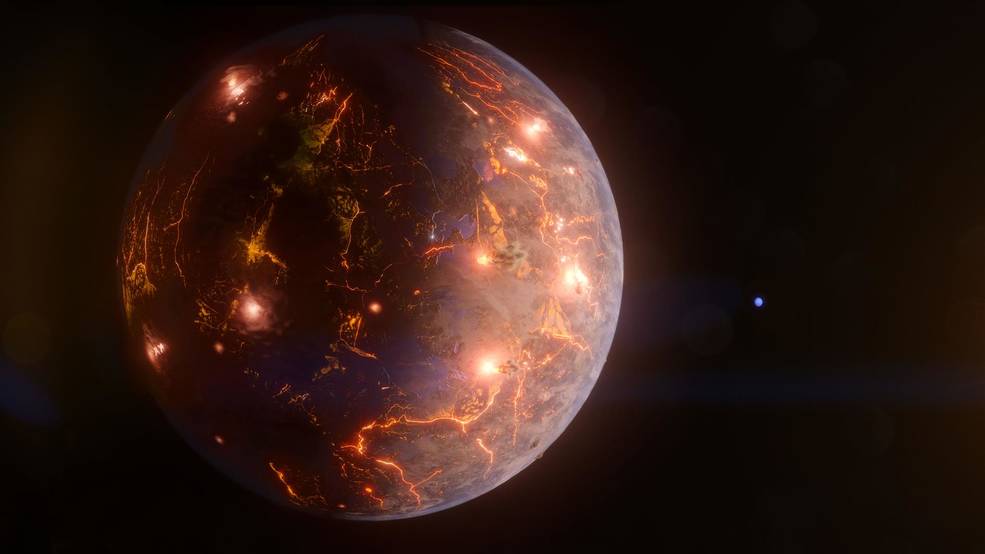Astronomers are working hard to understand biosignatures and how they indicate life’s presence on an exoplanet. But each planet we encounter is a unique puzzle. When it comes to planetary atmospheres, carbon is a big piece of the puzzle because it has a powerful effect on climate and biogeochemistry. If scientists can figure out how and where a planet’s carbon comes from and how it behaves in the atmosphere, they’ve made progress in solving the puzzle.
But one of the problems with carbon in exoplanet atmospheres is that it can send mixed signals.
Carbon, in this context, means all of the major species of carbon, things like carbon dioxide, carbon monoxide, and methane (CO2, CO, and CH4.) A new study investigates the diversity of these chemicals in the atmospheres of exoplanets similar to Earth orbiting stars similar to the Sun.
The study is “Relative abundances of CO2, CO, and CH4 in atmospheres of Earth-like lifeless planets.” It’s been submitted to The Astrophysical Journal and is available on the pre-press site arxiv.org. The authors are Yasuto Watanabe and Kazumi Ozaki. Watanabe is affiliated with the Department of Earth and Planetary Science at the University of Tokyo, and Ozaki is affiliated with the Department of Earth and Planetary Sciences at the Tokyo Institute of Technology.
The study is particularly concerned with CO. “We focused on the conditions for the formation of a CO-rich atmosphere, which would be favourable for the origin of life,” the authors write.

In Earth’s present atmosphere, CO can’t build up because chemical reactions destroy it. But in the deep past, three billion years ago, when the oceans were teeming with simple life, CO could’ve accumulated in Earth’s atmosphere. It’s because there was very little oxygen in the atmosphere, and the Sun was dimmer.
So when we’re searching for biosignatures, an atmosphere with CO could indicate simple life. That’s because it can be an important source of both carbon and oxygen for life. But it’s not that cut and dried. This study aims to untangle some of the details of exoplanet atmospheres so we can identify which mixtures of carbon molecules, including carbon monoxide, might be a biosignature.
“Consequently, a detailed understanding of those factors that govern the relative abundances of CO2, CO, and CH4 in planetary atmospheres has far-reaching implications in the search for habitable planets beyond our solar system,” the paper states.
A key concept in this research is called CO runaway. In an atmosphere like early Earth’s, which contained very little oxygen, CO is produced by photodissociation from UV radiation. On the other side of the equation, it’s destroyed by chemical reactions stemming from the photodissociation of water. When conditions are right, more CO is produced than destroyed, and that can lead to CO runaway.
Understanding CO runaway is critical in the appearance of life because prebiotic chemicals necessary for life—especially peptides—are more readily created in a CO-rich atmosphere than in a CO2-rich atmosphere. Evidence from Mars bolsters this point.
The pair of researchers used atmospheric chemistry models to investigate the details behind CO runaway and how it might help us discern which exoplanets could shelter life.

Planets are complicated feedback mechanisms between oceans, land, and atmospheres. Stars play an important role, too, partly because their UV light drives photodissociation. Every system is slightly different, and sometimes—or at least once—they lead to life. If the researchers are right, and CO runaway is a biosignature, then they’re onto something.
In their simulated atmospheres, CO runaway played an important role. “… the atmospheric chemistry is clearly divided into the groups before and after the occurrence of CO runaway,” they explain.
The researchers found an observable gap in atmospheric chemistry that’s important for life. “Our systematic examinations reveal that atmospheric chemistry can be clearly classified in the phase space of pCH4/pCO2 versus pCO/pCO2, where a distinct gap structure appears.”

So can planetary scientists look for this gap as a biosignature? It’s not quite that simple, and one thing clouds the results: volcanoes.

Magma can change the atmosphere by outgassing more CO than CH4. So it could lead to CO runaway without the need for UV energy to drive the production and accumulation of CO. “Our results for the prebiotic Earth conditions demonstrate that photochemical instability of CO (i.e., CO runaway) tends to be triggered by higher atmospheric pCO2 levels and increased outgassing fluxes of reducing gases,” they write.
The pair of researchers haven’t given us a sure-fire way to detect biosignatures. But what they’ve done is lay a path for future research that could get us closer to greater certainty when it comes to biosignatures. “… the CO runaway gap structure would be a general feature of Earth-like planets orbiting Sun-like stars,” they write.
Here’s what it boils down to: “Therefore, for better constraint on the conditions required for CO runaway, coupled modelling of atmospheric and solid-Earth processes is critical,” the researchers write. Solid-Earth processes are processes that occur in the crust, mantle, and core. So basically, volcanoes.
Research like this always leads to more questions that need to be investigated. But for the rest of us who aren’t scientists, this work illustrates the extraordinary complexity behind planets, chemistry, and life, and behind some of the simple headlines we see about habitable exoplanets.
“These results advance our understanding of the intricate relationship between the spectral types of central stars, atmospheric composition, climate, tectonic activity, and the origin of life, contributing to the
ongoing exploration of habitable worlds beyond our solar system,” they conclude.

